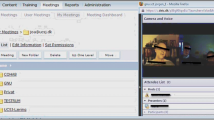Abstract
Boundary objects can provide bridges across boundaries and facilitate collaboration between learners with different backgrounds. In this paper, we explore cooperation in a cross-disciplinary and cross-cultural context, focusing on the opportunities for learning that arise at different boundaries and on corresponding boundary objects to facilitate both collaboration and learning. We present and discuss a study we conducted within a Cooperation Technology course. The discussion provides implications for collaboration support across boundaries, including insights on why they are important, how to facilitate their creation, and how to use technologies for that.
Access this chapter
Tax calculation will be finalised at checkout
Purchases are for personal use only
Preview
Unable to display preview. Download preview PDF.
Similar content being viewed by others
References
Fischer, G.: Distances and Diversity: Sources for Social Creativity. In: 5th Conference on Creativity & Cognition, April 12–15, pp. 128–136. ACM, London (2005)
Fischer, G., Rohde, M., Wulf, V.: Community-Based Learning: The Core Competency of Residential, Research Based Universities. International Journal for Computer-Supported Collaborative Learning 2(1), 9–40 (2007)
Anisetty, P., Young, P.: Collaboration problems in conducting a group project in a software engineering course. Journal of Computing Sciences in Colleges 26(5), 45–52 (2011)
Shuangyan, L., Joy, M., Griffiths, N.: Students’ Perceptions of the Factors Leading to Unsuccessful Group Collaboration. In: Jemni, M., Kinshuk Sampson, D., Spector, J.M. (eds.) 10th International Conference on Advanced Learning Technologies (ICALT), Sousse, Tunisia, July 5-7, pp. 565–569. IEEE (2010)
Wenger, E.: Communities of Practice and Social Learning Systems. Organization 7(2), 225–246 (2000)
Fischer, G.: External and shareable artifacts as opportunities for social creativity in communities of interest. In: Gero, J.S., Maher, M.L. (eds.) 5th International Conference on Computational and Cognitive Models of Creative Design, Heron Island, Australia, December 9-13, pp. 67–89. University of Sydney (2001)
Star, S., Griesemer, J.: Institutional Ecology, ‘Translations’ and Boundary Objects: Amateurs and Professionals in Berkeley’s Museum of Vertebrate Zoology, 1907-39. Social Studies of Science 19(3), 387–420 (1989)
Arias, E.G., Fischer, G.: Boundary Objects: Their Role in Articulating the Task at Hand and Making Information Relevant to It. In: International Symposium on Interactive & Collaborative Computing (ICC), Wollongong, Australia, December 12-15, pp. 567–574. ICSC Academic Press (2000)
Star, S.L.: The Structure of Ill-Structured Solutions: Boundary Objects and Heterogeneous Distributed Problem Solving. In: Distributed Artificial Intelligence, vol. II. Morgan Kaufmann Publishers Inc., San Mateo (1989)
Vygotsky, L.S.: Mind in society: the development of higher psychological processes. Harvard University Press, Cambridge (1978)
Prasolova-Førland, E.: Virtual spaces as artifacts: implications for the design of educational CVEs. In: International Conference on Cyberworlds, Singapore, December 3-5, pp. 396–403 (2003)
Fischer, G., Ostwald, J.: Knowledge Communication in Design Communities: And How They May Be Overcome. In: Bromme, R., Hesse, F., Spada, H. (eds.) Barriers and Biases in Computer-Mediated Knowledge Communication. Computer-Supported Collaborative Learning Series, vol. 5, pp. 213–242. Springer (2005)
Huang, E.Y., Huang, T.K.: Measuring Boundary Objects in an Attempt to Explain Innovativeness. In: Ralph, H., Sprague, J. (eds.) 46th Hawaii International Conference on System Sciences (HICSS), Wailea, HI, USA, January 7-10, pp. 3645–3653. IEEE (2013)
Beddall-Hill, N.L., Jonathan, R.: Mobile Devices as ‘Boundary Objects’ on Field Trips. Journal of the Research Center for Educational Technology 6(1), 28–46 (2010)
Nolen, S.B., Horn, I.S., Ward, C.J., Childers, S.A.: Novice Teacher Learning and Motivation Across Contexts: Assessment Tools as Boundary Objects. Cognition and Instruction 29(1), 88–122 (2011)
Jansen, A., Herbel-Eisenmann, B., Smith, J.P.: Detecting Students’ Experiences of Discontinuities Between Middle School and High School Mathematics Programs: Learning During Boundary Crossing. Mathematical Thinking and Learning 14(4), 285–309 (2012)
Boud, D., Cressey, P., Docherty, P.: Productive reflection at work: learning for changing organizations. Routledge, London (2006)
Morozov, M., Gerasimov, A., Fominykh, M.: vAcademia – Educational Virtual World with 3D Recording. In: Kuijper, A., Sourin, A. (eds.) 12th International Conference on Cyberworlds (CW), Darmstadt, Germany, September 25-27, pp. 199–206. IEEE (2012)
Boud, D., Keogh, R., Walker, D.: Reflection: Turning Experience into Learning. Kogan Page, London (1985)
Glaser, B.G.: The Constant Comparative Method of Qualitative Analysis. Social Problems 12(4), 436–445 (1965)
Gibbs, G.R.: Analysing Qualitative Data. SAGE Publications, London (2008)
Ryan, G.W., Bernard, H.R.: Techniques to Identify Themes. Field Methods 15(1), 85–109 (2003)
Engeström, Y.: Learning by expanding: An activity-theoretical approach to developmental research. Orienta-Konsultit Oy, Helsinki (1987)
Author information
Authors and Affiliations
Editor information
Editors and Affiliations
Rights and permissions
Copyright information
© 2013 Springer-Verlag Berlin Heidelberg
About this paper
Cite this paper
Fominykh, M., Prasolova-Førland, E., Petersen, S.A., Divitini, M. (2013). Work and Learning across Boundaries: Artifacts, Discourses, and Processes in a University Course. In: Antunes, P., Gerosa, M.A., Sylvester, A., Vassileva, J., de Vreede, GJ. (eds) Collaboration and Technology. CRIWG 2013. Lecture Notes in Computer Science, vol 8224. Springer, Berlin, Heidelberg. https://doi.org/10.1007/978-3-642-41347-6_12
Download citation
DOI: https://doi.org/10.1007/978-3-642-41347-6_12
Publisher Name: Springer, Berlin, Heidelberg
Print ISBN: 978-3-642-41346-9
Online ISBN: 978-3-642-41347-6
eBook Packages: Computer ScienceComputer Science (R0)




